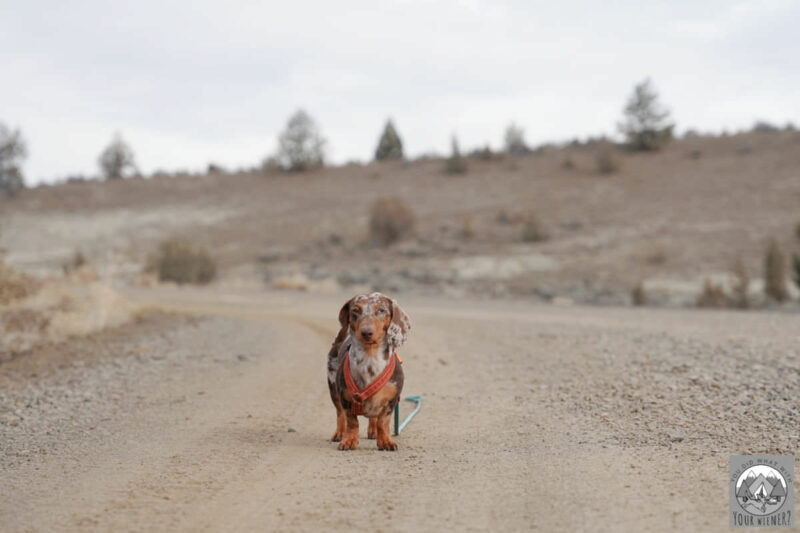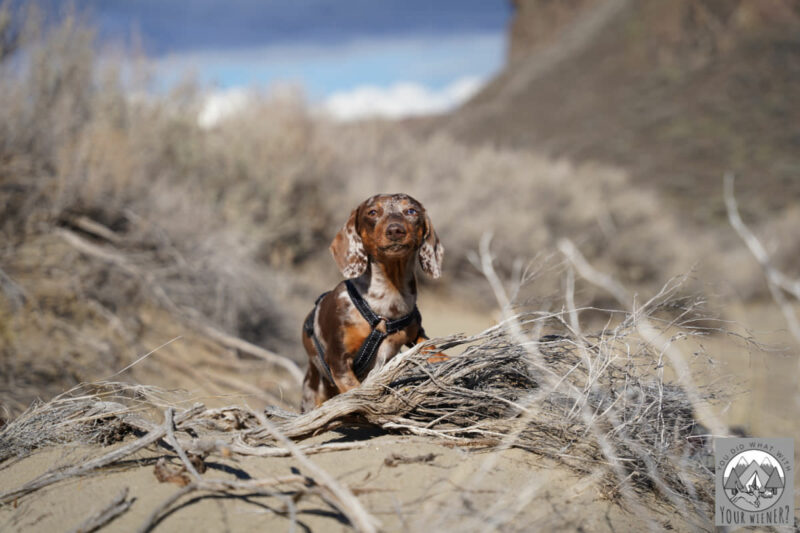There are numerous risks that we may encounter when adventuring outdoors, depending on our location.
From dangerous algae within the waterways to running right into a bear within the woods, outdoor adventurers have to be prepared.
UPDATED: This text was originally published in July of 2012.

For a lot of positioned within the western states, or who travel there, the chance of valley fever in dogs is one which you ought to be aware of.
But what’s valley fever, also known as ‘canine valley fever’, and how are you going to keep your dog protected?
In this text, I’m going to share every part that you must know.
What’s Valley Fever in Dogs?
Valley fever is a fungal infection that happens when a dog breathes within the fungi spores from the fungus Coccidioides.
After the dog inhales the spores into their lungs, they grow into spherules.
That is the thick-walled, non-budding form that the fungus will take when it’s in tissue. They contain a granule material referred to as endospores.
The spherules will proceed to grow and enlarge until they burst, releasing the endospores to spread the infection further as they take root and grow into recent spherules.
In lots of cases, the immune system can fight off infections within the early stages.
Nonetheless, if it doesn’t kill the spherules and endospores quickly enough, they may proceed to spread through the lungs and even throughout the body.
That is when the illness valley fever occurs.
How Does a Dog Get Valley Fever?
The fungus liable for valley fever grows within the soil.
It thrives in areas that have mild winters, hot summers, and low rainfall.
When the soil is disturbed, the microscopic fungal spores are released into the air.
Your dog can get valley fever from inhaling those spores.
That’s right, your dog can get this disease just from BREATHING!
There are numerous ways in which the soil will be stirred up or disturbed enough to release the spores.
This includes outdoor activities like mountaineering and biking, construction, and even a powerful enough wind.
My friend’s dog got it after digging in his Grandmother’s yard in Arizona. It wasn’t even from being out exploring!
Dogs are at high risk of exposure because they have an inclination to play within the dirt.
Whether a dog is digging within the dirt or rolling in it, they’re disturbing the soil in the realm directly around their faces.
Studies have revealed that Boxers and Golden Retrievers usually tend to be diagnosed with Valley Fever, but they aren’t the one dogs in danger.
Any dog that spends time outdoors in an area with the fungus will be exposed, regardless of the breed.
My friend’s dog that I previously mentioned is a Dachshund (who loved to dig).
The excellent news is that valley fever shouldn’t be contagious.
If you might have multiple dogs, they can not pass it from dog to dog.
Where Can My Dog Get Valley Fever?
Most dog owners which have heard of Valley Fever connect it with Arizona as a result of the massive variety of outbreaks which have been reported in that state.


That is for good reason with roughly 2/3 of the cases in america occurring in that area.
But there are a lot of other areas that we should always concentrate on.
For instance, when viewing the CDC’s map of reported cases in america, you may see that there’s a risk of valley fever in Washington State, where we live.
This led to my interest in learning more about valley fever.
Since moving to the east side of Washington Sate, we’re doing more mountaineering and camping within the desert and I would like to know tips on how to protect my dogs.
There are two several types of fungi liable for Valley fever – Coccidioides immitis and Coccidioides posadasii.
While these two varieties of fungi thrive in barely different climates and environmental settings, they’ll each cause serious illness in each you and your dog.
C. posadasii is usually positioned in:
- Arizona
- Recent Mexico
- Nevada
- Utah
- Texas
- Parts of southern California
C. immitis is primarily present in California in addition to in Washington State.
Outside of those areas, the chance is significantly lower. But there are cases of valley fever reported as far-off from these areas as Recent Hampshire, Rhode Island, and Delaware.
For those considering traveling internationally, the fungi are also present in parts of Mexico, Central America, and South America.
Signs of Valley Fever in Dogs
If you might have recently frolicked in an area where valley fever can have been present and your dog is acting ‘off’, it’s possible you’ll be wondering tips on how to tell in case your dog is sick.
When my friend told me about his dog, acting ‘off’ he said his dog was lethargic, panting, and clearly not feeling well.

 Photo Courtesy of Austin Westphal
Photo Courtesy of Austin Westphal
As with many pups which can be showing early symptoms of valley fever in dogs, his dog was originally diagnosed with pneumonia.
After further testing, it was discovered that his Dachshund had valley fever.
It shouldn’t be unusual for valley fever to be misdiagnosed or undiagnosed.
When you’re coping with valley fever in dogs, symptoms are sometimes shared with many other illnesses, which might make it hard to pinpoint a precise cause.
To diagnose your dog accurately, tests will must be done by your veterinarian.
Essentially the most common valley fever dog symptoms to observe out for include:
- Harsh, dry cough
- Fever
- Lack of appetite
- Weight reduction
- Lethargy or low energy
- Depression
If the illness continues to spread outside of the lungs and into other areas of your dog’s body, they might experience:
- Soft abscess-like swelling under the skin
- Skin wounds that ooze fluid and won’t heal
- Swollen lymph nodes under the chin, in front of the shoulder blades, or behind the stifles
- Inflamed, painful joints
- Swollen limbs
- Lameness
- Back or neck pain
- Swollen testicles
- Eye inflammation causing pain, cloudiness, or blindness
- Weakness or paralysis
- Unexpected heart failure in a young dog
When the illness isn’t caught early, it could possibly also trigger secondary illnesses like a lung infection or pneumonia, because it did within the case of my friend’s dog.
In some rare cases, the fungus can spread to the brain causing it to swell.
In these more serious examples of valley fever in dogs, neurological symptoms like seizure activity could also be seen.
Is Valley Fever Curable?
If you might have come across this text since you were researching the signs of infection listed above, it’s possible you’ll be wondering – My dog has valley fever, now what? Is there a cure?
There may be currently no cure for valley fever
But there are treatment options to handle the symptoms and support the immune system because it fights the fungal infection.
With early diagnosis of valley fever in dogs, the survival rate is high.
Valley Fever Treatment in Dogs
Essentially the most common treatment for valley fever in dogs is using antifungal medications.
In cases where the fungus is restricted to the lungs, treatment often lasts 6 to 12 months. Nonetheless, if the fungus has spread, prolonged treatment could also be needed.
If the fungus has reached the nervous system, antifungal medications are sometimes required for the remainder of the dog’s life.
The medications which can be most prescribed for treatment of valley fever include:
- Fluconazole (Diflucan)
- Itraconazole (Sporanox)
- Ketoconazole (Nizoral)
For dogs which have bone or joint infections, pain medication and anti-inflammatories can also be given to maintain your dog comfortable while the antifungal medications work.
Dogs with probably the most severe cases may must be hospitalized where they’ll receive intravenous antifungal medication, supportive therapy, and ongoing supervision.
Serious cases to this extent are usually not common, but they do occur.
If a dog suffers extensive damage to the lungs from the fungal infection, they might need surgery to remove the diseased lung to provide the most effective likelihood of survival.
Unfortunately, tests, medications, surgeries, and hospital stays can all come at a high cost. If you might have invested in pet insurance to your dog, a few of these costs could also be covered.
Are There Natural Remedies for Valley Fever in Dogs?
I’m not a veterinarian.
While I did investigate natural remedies, I might not recommend a natural treatment or “home cure” for anything this serious without first consulting along with your veterinarian.
While I used to be unable to seek out any credible recommendations for natural treatments, I did find some options to SUPPLEMENT traditional treatment.
This includes remedies to handle the symptoms during treatment in addition to supplements to support and boost the immune system.
CBD oils have been gaining attention and recognition in recent times as a result of their ability to naturally reduce pain and inflammation. This might be a substitute for pain medications to alleviate discomfort.
Other options to handle the symptoms may include natural cough suppressants and natural appetite stimulants.
In my research, I did discover a Canine “Valley Fever Package” of supplements that features a natural combination of vitamins, minerals, and antioxidants to spice up the immune system and support lung function. These may also help to further strengthen traditional treatment.


How Can I Prevent My Dog from Getting Valley Fever?
There may be currently no vaccine to guard dogs from valley fever. But there may be one under development that might make a giant difference for those who recurrently spend time in high-risk areas.
I imagine that you ought to be aware of valley fever and take precautions, where it is smart, but don’t let it stop you and your dog from having fun with life.
Only a small percentage of the pets living in or visiting areas where it’s present within the soil will contract valley fever.
But there are steps you can take to further lower your dog’s risk.
When you’re out mountaineering or exploring along with your dog, discourage any digging or sniffing of rodent holes.
While the fungus spores will be stirred up just from walking, the prospect of inhaling the fungal spores is way higher with these activities.
They not only involve disturbing the bottom but additionally position your dog’s nose right within the dust because it is stirred up.
Plan your outdoor adventures with the weather in mind. Listen to the weather forecast and avoid going outdoors during conditions like dust storms that might increase your risk.
One other other option is to deal with boosting your dog’s overall health and immune system with supplements.
This can help to extend the probabilities that your dog’s natural line of defense can fight off any potential illness if he’s exposed to the spores.
Most significantly, be certain that you just are aware of the signs of valley fever in dogs and speak to your veterinarian if you might have any reason to be concerned.

